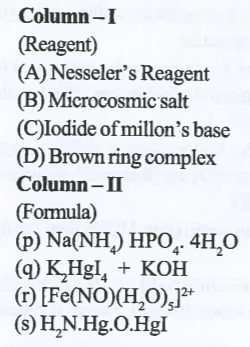match the following: a. ICNB (column I) and (i) bacteriophage (column II). (b) ICNCP(column I) and (ii) animals(column II). (c)ICVCN( column I) and (iii) Vibrio cholerae (column II). (d)ICZN(column I) and (iv) cultivated plants (column II)
a(iii), b(iv), c(i), d(ii)
a(iii), b(ii), c(iv), d(i)
a(ii), b(iii), c(i), d(iv)
a(iii), b(i), c(iv), d(ii)
The correct Answer is:A
To solve the matching question, we need to identify the correct associations between the items in Column I (ICNB, ICNCP, ICVCN, ICZN) and Column II (bacteriophage, animals, Vibrio cholerae, cultivated plants).
1. Identify ICNB:
- ICNB stands for the International Code of Nomenclature for Bacteria.
- The organism that corresponds to this code is Vibrio cholerae (a type of bacteria).
- Match: ICNB → (iii) Vibrio cholerae.
2. Identify ICNCP:
- ICNCP stands for the International Code of Nomenclature for Cultivated Plants.
- This code is related to cultivated plants.
- Match: ICNCP → (iv) cultivated plants.
3. Identify ICVCN:
- ICVCN stands for the International Code of Viral Nomenclature.
- This code is used for naming bacteriophages (viruses that infect bacteria).
- Match: ICVCN → (i) bacteriophage.
4. Identify ICZN:
- ICZN stands for the International Code of Zoological Nomenclature.
- This code is used for naming animals.
- Match: ICZN → (ii) animals.
Final Matches:
- a. ICNB → (iii) Vibrio cholerae
- b. ICNCP → (iv) cultivated plants
- c. ICVCN → (i) bacteriophage
- d. ICZN → (ii) animals
Summary of Matches:
- (a) ICNB → (iii) Vibrio cholerae
- (b) ICNCP → (iv) cultivated plants
- (c) ICVCN → (i) bacteriophage
- (d) ICZN → (ii) animals
Final Answer:
The correct matching is:
- a - iii
- b - iv
- c - i
- d - ii
- ICNB stands for the International Code of Nomenclature for Bacteria.
- The organism that corresponds to this code is Vibrio cholerae (a type of bacteria).
- Match: ICNB → (iii) Vibrio cholerae.
- ICNCP stands for the International Code of Nomenclature for Cultivated Plants.
- This code is related to cultivated plants.
- Match: ICNCP → (iv) cultivated plants.
- ICVCN stands for the International Code of Viral Nomenclature.
- This code is used for naming bacteriophages (viruses that infect bacteria).
- Match: ICVCN → (i) bacteriophage.
- ICZN stands for the International Code of Zoological Nomenclature.
- This code is used for naming animals.
- Match: ICZN → (ii) animals.
- a. ICNB → (iii) Vibrio cholerae
- b. ICNCP → (iv) cultivated plants
- c. ICVCN → (i) bacteriophage
- d. ICZN → (ii) animals
- (a) ICNB → (iii) Vibrio cholerae
- (b) ICNCP → (iv) cultivated plants
- (c) ICVCN → (i) bacteriophage
- (d) ICZN → (ii) animals
The correct matching is:
- a - iii
- b - iv
- c - i
- d - ii
Topper's Solved these Questions
Similar Questions
Knowledge Check
Match the columns and choose the correct answer.
(a) Aldosterone (Column I) (i) Zona fasciculata (Column II) (b) DHEA (Column I) (ii) Zona glomerulosa (Column II) (c) Cortisol (Column I) (iii) Zona reticulans (Column II) (d) Adrenaline (Column I) (iv) Adrenal medulla (Column II)Aa(i), b(ii), c(iii), d(iv)Ba(ii), b(iii), c(i), d(iv)Ca(iii), b(ii), c(i), d(iv)Da(iii), b(i), c(ii), d(iv)match the following column a. small pox (column I) b.German measles(column I) c.Mumps(column I) d.AIDS(column I) e. Polimyelitis (column I) . (i) paramyxo virus (column II) (ii) polio virus(column II) (iii) variola virus (column II) ( iv) Rubella virus(column II) (v) Retro virus(column II).
Aa(v), b(ii), c(iv), d(iii), e(i)Ba(i), b(ii), c(iii), d(iv) , e(v)Ca(iii), b(iv) , c(i), d(v) , e(ii)Da(v), b(iv), c(ii), d(iii), e(i)Match the column -I with column -II :
 AÂ A - q, B - r, C - s, D - pBA - p, B - q, C- r, D - sCÂ A r, B - s, C - p, D- qDA -s, B - p, C-q, D - r
AÂ A - q, B - r, C - s, D - pBA - p, B - q, C- r, D - sCÂ A r, B - s, C - p, D- qDA -s, B - p, C-q, D - r
Match the column I with the column II

View SolutionMatch Column - I with Column - II,(a) UGG(Column I),(i)Termination code(Column II),(b) GUG(Column I),(ii) Initiator codon(Column II),(c) UAA (Column I),(iii) Ambiguous codon(Column II),(d) AUG(Column I),(iv) Non - degenerate codon(Column II)
View SolutionMatch Column I with Column II. (a) Physalia (Column I),(i) Devil fish (Column II),(b) Ascaris (Column I),(ii) King crab (Column II),(c) Limulus (Column I),(iii) Roundworm (Column II),(d) Octopus (Column I),(iv) Portuguese man of war (Column II)
View SolutionMatch the Column I with II Column II
View SolutionMatch the column I with Column II

View Solution


